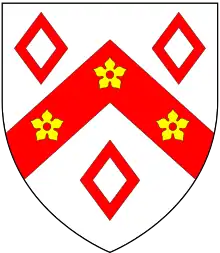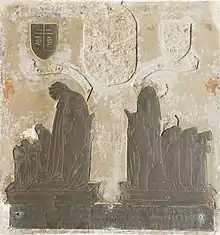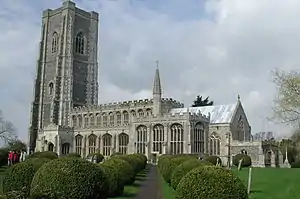Thomas Spring of Lavenham
Thomas Spring (c. 1474 – 1523), (alias Thomas Spring III or The Rich Clothier), of Lavenham in Suffolk, was an English cloth merchant.[2] He consolidated his father's business to become one of the most successful in the booming wool trade of the period and was one of the richest men in England.[3]
Thomas Spring | |
|---|---|
 Arms granted during the reign of King Henry VIII (1509-1547) to "Thomas Spring of Lavenham": Argent, on a chevron between three mascles gules as many cinquefoils or[1] | |
| Born | c. 1474 |
| Died | 1523 |
| Burial place | Lavenham, Suffolk |
| Occupation | Cloth merchant |
| Spouse(s) | Anne King Alice Appleton |
| Children | Sir John Spring Robert Spring Anne Spring Rose Spring Bridget Spring |
| Parent(s) | Thomas Spring, Margaret Appleton |



Origins
Thomas III Spring was the eldest son and heir of Thomas II Spring (d. 7 September 1486)[4] of Lavenham (whose monumental brass survives in Lavenham Church), by his wife Margaret Appleton. His father's will mentions Thomas and two other sons, William and James (slain 1493),[4] as well as a daughter, Marian.[5] He had another brother, John Spring, whose daughter, Margaret Spring, married Aubrey de Vere, second son of John de Vere, 15th Earl of Oxford and was the grandmother of Robert de Vere, 19th Earl of Oxford.[6]
The will of Thomas Spring's grandfather, Thomas I Spring (d.1440), mentions his wife, Agnes, his eldest son and heir, Thomas (d. 7 September 1486), another son William, and two daughters, Katherine and Dionyse.[7]
Career
Thomas inherited the family wool and cloth business from his father, and during his lifetime the cloth trade was at its most profitable. By the time of his death, Spring was believed to be the richest man in England outside the peerage, having invested much of his money in land.[8][9]
In 1512, 1513 and 1517 his name appears as one of the commissioners for collecting taxation in Suffolk. He played a large part in defeating supporters of William de la Pole, 1st Duke of Suffolk, who claimed the throne from King Henry VII. However, in 1517 during the reign of Henry VIII, Spring was given exemption from public duties,[10] At which point he was probably at the height of his wealth.
Spring is mentioned in John Skelton's satirical poem Why come ye not to Court, which makes reference to a rich clothier with whom Skelton is said to have been friends:[9]
- "Now nothing, but pay pay with laughe and lay downe Borough, Citie and towne good Springe of Lanam must count what became of his clothe makyng. My Lordes grace will bryng down thys hye Springe and brynge it so lowe it shal not ever flow."
Like his father, Thomas Spring was closely involved in the rebuilding of St Peter and St Paul's Church in Lavenham. This was partly done in order to propitiate the 13th Earl of Oxford, who had ordered the reconstruction work and was the other principal donor. The rebuilding also gave Spring an opportunity to display his wealth and generosity, thus solidifying his position in Suffolk; a common motivation behind the construction of many similar so-called "wool churches".
Marriage and issue
Thomas Spring married twice:
- Firstly, in 1493, to Anne King, of Boxford, Suffolk, by whom he had two sons and two daughters:
- Sir John Spring (d. 12 August 1547), of Lavenham, eldest son and heir, who married Dorothy Waldegrave, a daughter of Sir William Waldegrave[11]
- Robert Spring (1502–1550), who left a will dated 10 October 1547 in which he mentions his wife Agnes, his eldest son and heir Thomas Spring of Castlemaine, six other sons (Jerome, Robert, John, Nicholas, Stephen and Henry, Parson of Icklingham), and two daughters Dorothy and Frances.[12] As overseer, he appointed Sir William Cordell.[13]
- Anne Spring[14] (1494–1528), who married Sir Thomas Jermyn (d.1552) of Rushbrooke in Suffolk.[15] After her death, Jermyn married secondly to Anne Drury.[16]
- Rose Spring (b.1496), who married Thomas Guybon.[15]
- Secondly he married a lady named Alice (d.1538),[17][18] the widow of a man surnamed May,[19] by whom he had a further daughter:
- Bridget Spring (1498–c.1557), who married firstly William Erneley (21 December 1501 – 20 January 1546), son of Sir John Erneley (c.1464–1520), Chief Justice of the Common Pleas, by whom she had two sons and two daughters,[20] and secondly to Sir Henry Hussey (d. 28 August 1557) of Slinfold in Sussex.[21][15]
Alice survived him by fifteen years. In her will, dated 13 April 1538, she mentions her daughter by Thomas Spring, Bridget, now the wife of William Erneley; her daughter Alice, now the wife of Richard Fulmerston, gentleman; and her daughter Margaret (died c. 1552), the wife of William Risby (died c. 1551).[22] She appoints as executors her daughter Margaret and sons-in-law, William Risby and Richard Fulmerston, and requests "my Lord of Oxenford" (John de Vere, 15th Earl of Oxford) to aid and defend my said executors."[23] In a codicil added 31 August 1538, she discharges Richard Fulmerston as executor, and appoints him supervisor. Both will and codicil were proved 5 September 1538.[23]
Death and burial
_ThomasSpring_Died1523_LavenhamChurch_Suffolk.jpg.webp)

Spring made his last will on 13 June 1523 as 'Thomas Spring of Lavenham, clothmaker', leaving to his wife Alice all her apparel and jewels, 1,000 marks in money and half his plate and implements of household, with the other half to go to John his eldest son and heir. Spring also left bequests to his son Robert, to his unmarried daughter Bridget, to the children of his married daughter Rose Guybon and to the children of his son-in-law Thomas Jermyn. To 'my wife's daughter, Alice May', he bequeathed £26 13s 4d, 'which I recovered for her of May's executors', to be paid to her at the age of sixteen.[24] A further sum of 5,000 marks was left in trust for future generations of Spring family members.
Thomas Spring was buried in the Church of Saint Peter and Saint Paul, Lavenham, before the altar of St Katherine, and his tomb was fenced in by the surviving elaborate wooden parclose screen[25] which in his will he ordered his executors to erect. His widow commissioned Flemish wood carvers to create a ten-foot high parclose screen around his tomb, which is one of the most intricate of its type still in existence.[26]
Further reading
See also
Notes
- Howard, Joseph Jackson, ed. (1868). The Visitation of Suffolke, made by William Hervey, Clarenceux King of Arms, 1561, with additions from family documents, original wills, Jermyn, Davy, and other MSS, &c.: Vol 2. Lowestoft & London, p.166
- Phil W Kaufman, American Traces in Anglian Places (Lulu.com), 19.
- The Cloth Industry of Lavenham Retrieved 25 April 2013.
- Burke & Burke 1838, p. 510.
- Betterton & Dymond 1989, p. 12; Howard 1866, p. 170.
- Anderson 1993, p. 141; Betterton & Dymond 1989, p. 51.
- Betterton & Dymond 1989, p. 10.
- The Cloth Industry of Lavenham Retrieved 25 April 2013.
- Walker 1988, p. 112.
- McClenaghan 1924, pp. 14–15
- Burke & Burke 1838, p. 501; Coppinger 1922, p. 177.
- Howard 1866, pp. 168, 181–3.
- Howard 1866, p. 183.
- Betterton states that the daughter who married Sir Thomas Jermyn was Margaret; Betterton & Dymond 1989, p. 51.
- http://www.oxford-shakespeare.com/Probate/PROB_11-21_ff_83-4.pdf
- Bethem 1803, p. 59.
- Betterton & Dymond 1989, p. 13.
- Burke states that Alice was Thomas Spring's first wife, and the mother of all his children; Burke & Burke 1838, p. 510.
- Betterton & Dymond 1989, p. 15.
- Erneley, William (1501-46), of Cakeham near West Wittering, Sussex, History of Parliament Retrieved 26 April 2013.
- Betterton & Dymond 1989, p. 51.
- Winthrop 1897, pp. 68–9; Howard 1866, pp. 173–6.
- Howard 1866, pp. 173–6.
- Betterton & Dymond 1989, pp. 14–15; Howard 1866, pp. 171–2.
- Betterton & Dymond 1989, pp. 14–15.
- Phil W Kaufman, American Traces in Anglian Places (Lulu.com), 19.
References
- Anderson, Verily (1993). A Genealogical and Heraldic History of the Extinct and Dormant Baronetcies of England. Lavenham, Suffolk: Terence Dalton Limited. p. 141.CS1 maint: ref=harv (link)
- Betham, William (1803). The Baronetage of England. III. London: W.S. Betham. p. 50. Retrieved 26 April 2013.CS1 maint: ref=harv (link)
- Betterton, Alec; Dymond, David (1989). Lavenham; Industrial Town. Lavenham, Suffolk: Terence Dalton Limited. p. 51.CS1 maint: ref=harv (link)
- Burke, John; Burke, John Bernard (1838). A Genealogical and Heraldic History of the Extinct and Dormant Baronetcies of England. London: Scott, Webster and Geary. p. 510. Retrieved 25 April 2013.CS1 maint: ref=harv (link)
- Howard, Joseph Jackson, ed. (1866). The Visitation of Suffolk. I. London: Whittaker and Co. pp. 165–206. Retrieved 26 April 2013.CS1 maint: ref=harv (link)
- Lee, John S. (2018). The Medieval Clothier. Woodbridge: Boydell. ISBN 9781783273171.
- McClenaghan, Barbara (1924). The Springs of Lavenham: And the Suffolk Cloth Trade in the XV and XVI Centuries. Cambridge: Cambridge University Press. p. 90.CS1 maint: ref=harv (link)
- Walker, Greg (1988). John Skelton and the Politics of the 1520s. Cambridge: Cambridge University Press. p. 112. ISBN 9780521521390. Retrieved 25 April 2013.CS1 maint: ref=harv (link)
- Winthrop, Robert C. (1897). Evidences of the Winthrops of Groton. Boston: Cambridge University Press. p. 68. Retrieved 26 April 2013.CS1 maint: ref=harv (link)
External links
- Will of Thomas Spring of Lavenham, Suffolk, clothmaker, proved 3 July 1523, National Archives Retrieved 25 April 2013
- Will of Alice Spring, widow, of Lavenham, proved 5 September 1538, National Archives Retrieved 26 April 2013
- Will of Thomas Appleton of Little Waldingfield, proved 9 February 1509, National Archives Retrieved 26 April 2013
- Will of John Spring of Hitcham, Suffolk, proved 21 May 1549, National Archives Retrieved 26 April 2013
- Will of Dame Dorothy Spring, widow, of Cockfield, Suffolk, proved 10 November 1564, National Archives Retrieved 26 April 2013
- Will of Sir William Waldegrave of Smallbridge, Suffolk, proved 6 March 1527 Retrieved 26 April 2013
- Will of Sir Thomas Jermyn of Rushbrooke, Suffolk, proved 16 December 1552, National Archives Retrieved 26 April 2013
- Will of Thomas Guybon of West Lynn, Norfolk, proved 14 November 1531, National Archives Retrieved 27 April 2013
- Will of Dame Bridget Hussey of West Wittering, Sussex, proved 2 May 1558, National Archives Retrieved 26 April 2013
- Will of William Erneley of Cakeham, Sussex, proved 28 February 1546, National Archives Retrieved 26 April 2013
- Will of Sir Henry Hussey of Slinfold, Sussex, proved 27 September 1557, National Archives Retrieved 26 April 2013
- Pakenham - Village of Two Mills Retrieved 26 April 2013